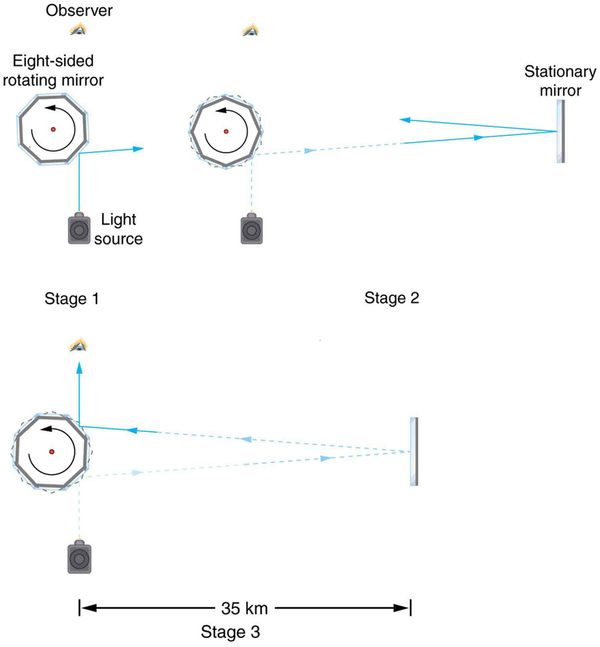| << Chapter < Page | Chapter >> Page > |

The speed of light is now known to great precision. In fact, the speed of light in a vacuum is so important that it is accepted as one of the basic physical quantities and has the fixed value
where the approximate value of is used whenever three-digit accuracy is sufficient. The speed of light through matter is less than it is in a vacuum, because light interacts with atoms in a material. The speed of light depends strongly on the type of material, since its interaction with different atoms, crystal lattices, and other substructures varies. We define the index of refraction of a material to be
where is the observed speed of light in the material. Since the speed of light is always less than in matter and equals only in a vacuum, the index of refraction is always greater than or equal to one.
That is, . [link] gives the indices of refraction for some representative substances. The values are listed for a particular wavelength of light, because they vary slightly with wavelength. (This can have important effects, such as colors produced by a prism.) Note that for gases, is close to 1.0. This seems reasonable, since atoms in gases are widely separated and light travels at in the vacuum between atoms. It is common to take for gases unless great precision is needed. Although the speed of light in a medium varies considerably from its value in a vacuum, it is still a large speed.
| Medium | n |
|---|---|
| Gases at , 1 atm | |
| Air | 1.000293 |
| Carbon dioxide | 1.00045 |
| Hydrogen | 1.000139 |
| Oxygen | 1.000271 |
| Liquids at | |
| Benzene | 1.501 |
| Carbon disulfide | 1.628 |
| Carbon tetrachloride | 1.461 |
| Ethanol | 1.361 |
| Glycerine | 1.473 |
| Water, fresh | 1.333 |
| Solids at | |
| Diamond | 2.419 |
| Fluorite | 1.434 |
| Glass, crown | 1.52 |
| Glass, flint | 1.66 |
| Ice at | 1.309 |
| Polystyrene | 1.49 |
| Plexiglas | 1.51 |
| Quartz, crystalline | 1.544 |
| Quartz, fused | 1.458 |
| Sodium chloride | 1.544 |
| Zircon | 1.923 |
Calculate the speed of light in zircon, a material used in jewelry to imitate diamond.
Strategy
The speed of light in a material, , can be calculated from the index of refraction of the material using the equation .
Solution
The equation for index of refraction states that . Rearranging this to determine gives
The index of refraction for zircon is given as 1.923 in [link] , and is given in the equation for speed of light. Entering these values in the last expression gives
Discussion
This speed is slightly larger than half the speed of light in a vacuum and is still high compared with speeds we normally experience. The only substance listed in [link] that has a greater index of refraction than zircon is diamond. We shall see later that the large index of refraction for zircon makes it sparkle more than glass, but less than diamond.

Notification Switch
Would you like to follow the 'Physics 101' conversation and receive update notifications?